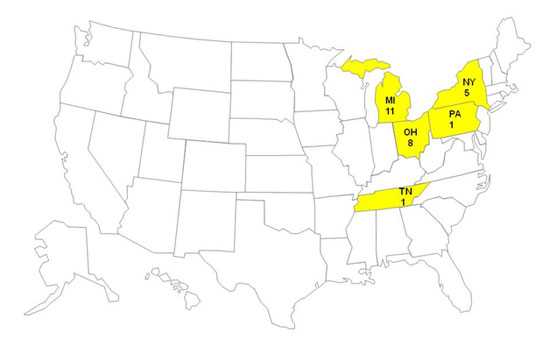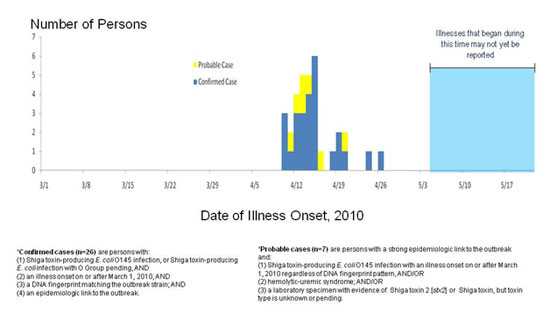Multistate Outbreak of Human E. coli O145 Infections Linked to Shredded Romaine Lettuce from a Single Processing Facility (FINAL UPDATE)
NOTICE: This outbreak is over. The information on this page has been archived for historical purposes only and will not be updated.
Posted May 21, 2010
Outbreak Summary
Local and state public health officials in Michigan, New York, Ohio, Pennsylvania, and Tennessee are investigating human illnesses caused by Escherichia coli (E. coli) O145. CDC is supporting these investigations and facilitating regular communication and information sharing between the states and with the U.S. Food and Drug Administration (FDA).
As of May 20, 2010, a total of 26 confirmed and 7 probable cases related to this outbreak have been reported from 5 states since March 1, 2010. The number of ill persons identified in each state with this strain is: MI (11 confirmed and 2 probable), NY (5 confirmed and 2 probable), OH (8 confirmed and 3 probable), PA (1 confirmed), and TN (1 confirmed). The reported cases in Tennessee and Pennsylvania do not reflect expansion of the outbreak but retrospective identification of cases using the PulseNet system – these cases are part of the original cluster due to the original implicated lot of lettuce from March.
Among the 30 patients with available information, 12 (40%) were hospitalized. Three patients have developed a type of kidney failure known as hemolytic uremic syndrome, or HUS. No deaths have been reported.
The outbreak can be visually described with a chart showing the number of persons who became ill each day. This chart is called an epidemic curve or epi curve. Of note, it takes an average of 2 to 3 weeks from the time a person becomes ill to the time when the illness is confirmed by laboratory testing and reported. Please see the Timeline for Reporting Cases of E. coli O157 Infection for more details.
The bacteria responsible for this outbreak are referred to as Shiga toxin-producing E. coli, or STEC. STECs have been associated with human illness, including bloody diarrhea and HUS. STEC bacteria are grouped by serogroups (e.g., O157 or O145). The STEC serogroup found most commonly in U.S. patients is E. coli O157. Other E. coli serogroups in the STEC group, including O145, are sometimes called “non-O157 STECs.” Currently, there are limited public health surveillance data on the occurrence of non-O157 STECs, including E. coli O145; therefore, E. coli O145 may go unreported. Because it is more difficult to identify than E. coli O157, many clinical laboratories do not test for non-O157 STEC infection.
Investigators are using pulsed-field gel electrophoresis (PFGE), a type of DNA fingerprint analysis of E. coli bacteria obtained through diagnostic testing to identify cases of illness that might be part of this outbreak. This testing is done in public health laboratories as part of the PulseNet network. Investigators have established a common definition of confirmed and probable cases related to this outbreak.
Confirmed cases are persons with:
- Shiga toxin-producing E. coli O145 infection, or Shiga toxin-producing E. coli infection with O Group pending, AND
- an illness onset on or after March 1, 2010, AND
- a DNA fingerprint matching the outbreak strain; AND
- an epidemiologic link to the outbreak.
Probable cases are persons with a strong epidemiologic link to the outbreak and
- Shiga toxin-producing E. coli O145 infection with an illness onset on or after March 1, 2010 regardless of DNA fingerprint pattern, AND/OR
- hemolytic uremic syndrome; AND/OR
- a laboratory specimen with evidence of Shiga toxin 2 [stx2] or Shiga toxin, but toxin type is unknown or pending.
Investigation of the Outbreak
Multiple lines of evidence have implicated shredded romaine lettuce from one processing facility as a source of infection in this outbreak. This evidence includes the identification of the outbreak strain of E. coli O145 from an unopened package of shredded romaine lettuce obtained at an institution that received product from the processing facility linked to the outbreak. Case-control studies in Michigan and Ohio found significant associations between illness and consumption of romaine lettuce processed at the same facility that processed lettuce consumed by ill persons in New York, Pennsylvania, and Tennessee.
The lettuce processing company has issued a recall of lettuce produced at their facility as a result of the evidence obtained to date. An additional recall was issued by a separate company that received lettuce from the same farm as the processing company linked to the outbreak.
Testing of shredded romaine lettuce from the processing company also identified an E. coli O143 producing Shiga toxin 1, which is different from the outbreak strain. This strain is not associated with any human illness, and appears to be an incidental finding.
Local, state, and federal health officials were involved in many different types of investigative activities, including:
- Conducting surveillance for additional illnesses that could be related to the outbreak.
- Conducting epidemiologic studies that includes gathering detailed information from ill persons (cases) and from healthy persons (controls) about foods recently eaten and other exposures.
- Gathering and testing food products that are suspected as possible sources of infection to see if they are contaminated with bacteria.
- Following any epidemiologic leads gathered from interviews with patients, food purchase information, or from patterns of processing, production and/or distribution of suspected products.
- FDA was working closely with its state partners in the investigations at the food processor and at the farm level to determine where in the distribution chain the point of contamination likely occurred.
Public health and agriculture officials in Michigan, New York, Ohio, Pennsylvania and Tennessee, along with CDC and FDA, are actively engaged in this investigation.
Timeline of Infections: Multistate Outbreak of E. coli O145 Infections Associated with Romaine Lettuce—United States, 2010
Public health authorities initially recognized an outbreak of bloody diarrhea in MI due to E. coli O145 on April 16, 2010 that was subsequently linked to other similar clusters in OH and NY. Preliminary information linked these illnesses to a common supplier of romaine lettuce on April 27, 2010. By April 28, 2010, FDA determined that the implicated romaine lettuce production lots were produced in late March from a single farm and accounted for all of the illnesses; these implicated lots were no longer in commerce and no recall was necessary. Subsequent laboratory investigations of romaine lettuce showed at least intermittent contamination on later production days from the processor and triggered preemptive recalls of initially a single contaminated lot, and then all production from the implicated farm. There has been no illness associated to date with these later lots of recalled lettuce. The reported cases in Tennessee and Pennsylvania do not reflect expansion of the outbreak but retrospective identification of cases using the PulseNet system—these cases are part of the original cluster due to the original implicated lot of lettuce from March.
Clinical Features/Signs and Symptoms
Most people infected with E. coli develop diarrhea (often bloody) and abdominal cramps 2-8 days (average of 3-4 days) after swallowing the organism, but some illnesses last longer and can be more severe. Infection is usually diagnosed by culture of a stool sample. Many clinical laboratories do not test for non-O157 STEC, such as E. coli O145, because identifying it is more difficult than for E. coli O157. Most people recover within a week, but some develop a severe infection. HUS can begin as the diarrhea is improving and can occur in people of any age but is most common in children under 5 years old and the elderly.
General Information
Additional Resources
Final Case Count Map
Persons infected with the outbreak strain of E. coli O145, by state, as of May 20, 2010 (n=26)

As of May 20, 2010, a total of 26 confirmed and 7 probable cases related to this outbreak have been reported from 5 states since March 1, 2010. The number of ill persons identified in each state with this strain is: MI (11 confirmed and 2 probable), NY (5 confirmed and 2 probable), OH (8 confirmed and 3 probable), PA (1 confirmed), and TN (1 confirmed). The reported cases in Tennessee and Pennsylvania do not reflect expansion of the outbreak but retrospective identification of cases using the PulseNet system – these cases are part of the original cluster due to the original implicated lot of lettuce from March.
Final Epi Curve
Confirmed and probable cases of E. coli O145 infection, United States, by date of illness onset*

*n=33 for whom information was available as of May 20, 2010
- Page last reviewed: May 21, 2010
- Page last updated: May 21, 2010
- Content source:


 ShareCompartir
ShareCompartir